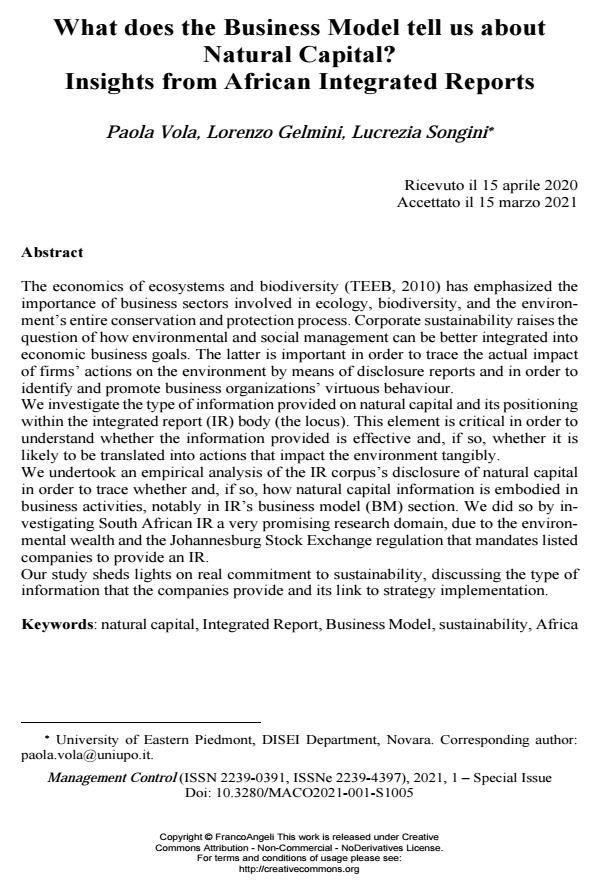What does the Business Model tell us about Natural Capital? Insights from African Integrated Reports
Titolo Rivista MANAGEMENT CONTROL
Autori/Curatori Paola Vola, Lorenzo Gelmini, Lucrezia Songini
Anno di pubblicazione 2021 Fascicolo 2021/suppl. 1
Lingua Inglese Numero pagine 22 P. 75-96 Dimensione file 224 KB
DOI 10.3280/MACO2021-001-S1005
Il DOI è il codice a barre della proprietà intellettuale: per saperne di più
clicca qui

FrancoAngeli è membro della Publishers International Linking Association, Inc (PILA)associazione indipendente e non profit per facilitare (attraverso i servizi tecnologici implementati da CrossRef.org) l’accesso degli studiosi ai contenuti digitali nelle pubblicazioni professionali e scientifiche
The economics of ecosystems and biodiversity (TEEB, 2010) has emphasized the importance of business sectors involved in ecology, biodiversity, and the environ-ment’s entire conservation and protection process. Corporate sustainability raises the question of how environmental and social management can be better integrat-ed into economic business goals. The latter is important in order to trace the actual impact of firms’ actions on the environment by means of disclosure reports and in order to identify and promote business organizations’ virtuous behaviour. We investigate the type of information provided on natural capital and its posi-tioning within the integrated report (IR) body (the locus). This element is critical in order to understand whether the information provided is effective and, if so, whether it is likely to be translated into actions that impact the environment tangi-bly. We undertook an empirical analysis of the IR corpus’s disclosure of natural capi-tal in order to trace whether and, if so, how natural capital information is embod-ied in business activities, notably in IR’s business model (BM) section. We did so by investigating South African IR a very promising research domain, due to the environmental wealth and the Johannesburg Stock Exchange regulation that mandates listed companies to provide an IR. Our study sheds lights on real commitment to sustainability, discussing the type of information that the companies provide and its link to strategy implementation.
Parole chiave:Natural capital, Integrated Report, Business Model, sustainability, Africa
- Linking business models and digital technologies through integrated reporting Manuel De Nicola, Anna Maria Maurizi, Francesco Mercuri, Francesco Paolone, in Business Strategy and the Environment /2024 pp.764
DOI: 10.1002/bse.3521 - Biodiversity accounting: a bibliometric analysis for comprehensive literature mapping Gennaro Maione, Corrado Cuccurullo, Aurelio Tommasetti, in Sustainability Accounting, Management and Policy Journal /2024 pp.1178
DOI: 10.1108/SAMPJ-04-2022-0214 - A Systemic Model of the Relationships between Companies, Biodiversity, and Ecosystems to Manage the Environmental Performance Lino Cinquini, Giacomo Pigatto, Andrea Tenucci, Niccolò Braico, in SSRN Electronic Journal /2024
DOI: 10.2139/ssrn.5024161 - What do companies report about their digital transformation? Manuel De Nicola, Anna Maria Maurizi, in MANAGEMENT CONTROL 2/2023 pp.165
DOI: 10.3280/MACO2023-002008 - Do women on corporate boards enhance biodiversity disclosure? Evidence from South Africa Reon Matemane, Titus Ayobami Ojeyinka, Abongeh A. Tunyi, Tesfaye Lemma, in Journal of Accounting in Emerging Economies /2025 pp.1
DOI: 10.1108/JAEE-02-2025-0058
Paola Vola, Lorenzo Gelmini, Lucrezia Songini, What does the Business Model tell us about Natural Capital? Insights from African Integrated Reports in "MANAGEMENT CONTROL" suppl. 1/2021, pp 75-96, DOI: 10.3280/MACO2021-001-S1005